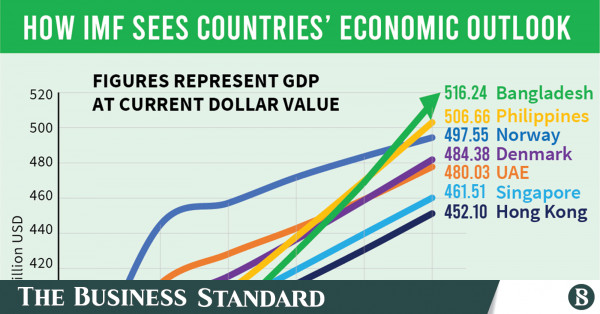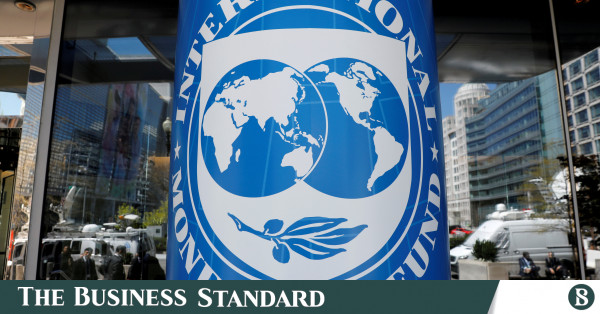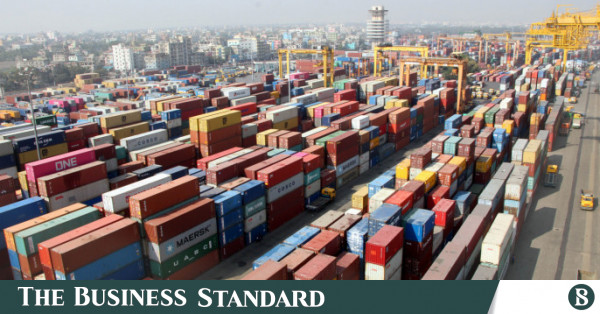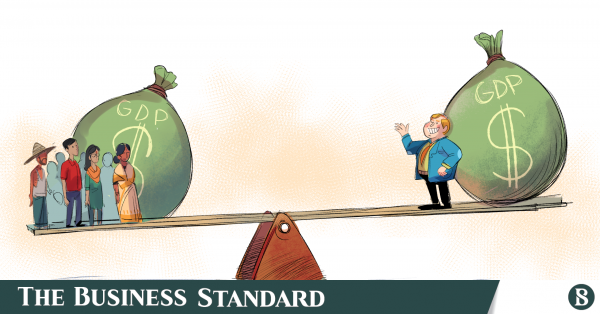Bangladesh's economy is projected to reach $516.24 billion in the fiscal 2024-25, outperforming advanced economies such as Denmark, Singapore and Hong Kong along the way, says the International Monetary Fund (IMF).
Denmark is expected to have a GDP of $484.38 billion at the current dollar value in 2025, while Singapore and Hong Kong will see their economies reach $461.51 billion and $452.10 billion, respectively.
The forecast was revealed in the IMF's World Economic Outlook database on Tuesday.
Approaching a $500 billion+ economy, Bangladesh would also surpass Norway ($497.55 billion), the Philippines ($506.66 billion) and even the oil-rich United Arab Emirates ($480.03 billion) by 2025.
According to the Bangladesh Bureau of Statistics (BBS), Bangladesh's GDP was $355 billion in FY21, up from $323 billion in the previous fiscal year.
Meanwhile, the IMF forecasted 6.54% real GDP growth for Bangladesh in the current fiscal year, which is expected to reach 7.2% in FY25.
Dr Zahid Hussain, former lead economist of the World Bank's Dhaka office, told The Business Standard, "These comparisons would only hold significance if we consider the overall economy as a market."
He said, "But if we want to know the real impact of this achievement and assess what would change in terms of employment generation, poverty, economic inclusion and so on, it has to be done on a per capita basis."
He further said, "Unless the effect of this growth trickles down to the larger portion of the population, it would not be inclusive.
"Industries inclined towards technology and capital-intensive production may benefit, but whether firms with larger labour forces will be included in this achievement is questionable."
With a current population of nearly 17 crore, Bangladesh's GDP per capita is projected to hit $2,994.46 in 2025, while Norway and Denmark will have a much higher GDP per capita, at $89,679.84 and $81,950.18, respectively.
Singapore and Hong Kong's GDP per capita will reach $79,169.49 and $59,126.85, respectively.
South Asian economies in 2025
South Asia's largest economy, India is projected to have a GDP of $4,084.69 billion in 2025.
Bangladesh has been the second-largest economy in the region since 2019 and it will continue to hold that position till 2025.
But in terms of GDP per capita, Bangladesh has already overtaken India in 2020 and will keep its position to reach $2,994.46 in FY25, while India's per capita GDP is slated to grow to $2,829.65.
Meanwhile, Sri Lanka's GDP is expected to reach $101.44 billion in 2025, followed by Nepal ($45.83 billion), and Maldives ($7.03 billion).
Bhutan, on the other hand, would remain at the bottom with a GDP of $3.62 billion.

Bangladesh’s GDP to surpass those of Denmark, Singapore, Hong Kong by 2025
The country’s GDP is expected to cross the $500 billion mark in FY25
Bangladesh's per capita gross domestic product (GDP) will be US$2,138.794 in 2021 which is higher than the neighboring India, according to the International Monetary Fund (IMF).
The per capita GDP of India will be US$2,116.444 in 2021.
The projection came from the World Economic Outlook 2021 of the IMF titled "Recovery During a Pandemic Health Concerns, Supply Disruptions and Price Pressures", released on Tuesday.
The Washington-based multilateral lender also projected that Bangladesh's economic growth will be 6.5 per cent in the current year. The IMF trimmed the projection for global growth to 5.9 per cent for this year in contrast to its previous estimation of 6.0 per cent. It, however, kept unchanged the global growth at 4.9 per cent for the next year.
"The global recovery continues, but the momentum has weakened, hobbled by the pandemic," said the report.
Pandemic outbreaks in critical links of global supply chains have resulted in longer-than-expected supply disruptions and further feeding inflation in
many countries, said the IMF.
"Overall, risks to economic prospects have increased and policy trade-offs have become more complex."
Partially offsetting those changes, projections for some commodity exporters have been upgraded on the back of rising commodity prices.
If higher inflation becomes entrenched, it could force central banks to respond aggressively and higher interest rates would slow the recovery, the IMF cautioned.

Bangladesh's per capita GDP to be $2,138.794 in 2021: IMF
Bangladesh's per capita gross domestic product (GDP) will be US$2,138.794 in 2021 which is higher than the neighboring India, according to the International Monetary Fund (IMF). The per capita GDP of India will be US$2,116.444 in 2021. The projection came from the World Economic Outlook 2021 of...
Bangladesh's economic growth will be led by government-run development projects in the current fiscal year as private sector credit growth still remains slow, according to top economists of Standard Chartered.
The private sector credit growth may rise in the coming months if the Covid situation remains under control and vaccination goes up to the mark, they said at a virtual event titled "Global Research Briefing (GRB) Bangladesh 2021 Media Session" on Thursday.
However, they said they are not confident enough that this growth will be notable before March-April of next year.
Saurav Anand, an economist of Standard Chartered for South Asia, said it is not only in Bangladesh, but the global scenario is also the same.
"Bangladesh's credit growth is 8.5%, while India's is closer to 6%. The private sector is resisting investment in terms of higher capacity building," he pointed out.
So, this year investments will be mostly driven by the government. Mega infrastructure projects from the government side are what will drive the investment part of economic growth, said Anand.
Private sector credit rose to 8.42% in August from 8.38% in July, according to the Bangladesh Bank. The July figure also improved by 0.40 percentage points from June although it was still 6.8 percentage points lower than the central bank's target.
The Bangladesh Bank in its monetary policy for the current fiscal year has set the target of private sector credit growth at 14.8%.
Anand further said, "There are so many projections, but I think if the Covid situation does not get worse, it will surely go to 7% plus growth in this fiscal year. So far, we see the country's economy stands at $350 billion and it will reach $500 billion by 2026."
Naser Ezaz Bijoy, chief executive officer at Standard Chartered Bangladesh, said, "As the vaccination drive continues, the economy is set to accelerate."
There are significant opportunities such as technology adoption and inclusiveness through mobile-based solutions and the ITeS [IT-enabled Services] sector, while growth-supportive policy focused sectors will continue to spur private investment and foreign direct investment."
Planning Minister MA Mannan said, "We remain as committed as ever in fostering a business-friendly climate so that we can continue our journey of inclusive progress and prosperity."
Eric Robertsen, global head of research and chief strategist of Standard Chartered, said pandemic-affected global export has almost returned to pre-pandemic level. "The speed of recovery has been much faster."
There are some significant risk factors, such as global debt deflation, associated with such a positive recovery in global trade, he said, adding, "In the global market, there are some inflationary problems with prices of crude oil, copper and natural gas rising."
Divya Devesh, head of Asa FX Research at Standard Chartered, said Taka is still best in the Asian market as Bangladesh is recovering from pandemic-induced economic downturn riding on high remittances, exports and reserves. So, Taka will outperform other Asian currencies in the coming days.
Bangladesh is on the path of returning to normalcy after a pandemic-hit period, with its exports having raked in $38.75 billion in FY21, the receipts amounted to $33.67 billion in FY20.
Recent studies show a ray of hope that the country can earn $22 billion more annually if liberal market access is utilised with diversified items.
On the other hand, remittance inflow dipped by 19.75% to $1.73 billion year-on-year in September, which was also the lowest in 16 months. Bangladeshi expatriates sent home $2.15 billion in September last year.
The amount remitted in September this year was 4.63% lower than the August earnings. In July-September of Fy22, total remittance inflow amounted to $5.40 billion, down from $6.71 billion during the same period last fiscal year.
The StanChart economists said recent Taka depreciation has been in line with their expectations.
They also said GDP growth will recover in FY22 on the back of domestic consumption and global growth rebound.
Stating that vaccination will continue to be a key driver, they said if vaccination continues at the current pace, StanChart expects a 70% vaccination threshold by June 2022.
The World Bank on Wednesday projected a 6.4% growth in the current fiscal year for Bangladesh. Meanwhile, growth for the next fiscal year was estimated at 6.9%, while StanChart economists forecasted that growth will sustain at over 7% during FY22-26, and per capita to $3,000 by FY26.

Govt dev projects to lead Bangladesh’s growth in FY22: StanChart
The momentum will be driven by an export demand recovery, strong remittance inflows and public investment, the StanChart economists said

Bangladesh to turn into $500b economy
Bangladesh may become a US$500 billion economy with the per-capita income rising to $3,000 by 2025-26 fiscal year on the back of a steady growth, Standard Chartered Bank predicts. The international bank reported Thursday the country's economic outlook that estimates a GDP growth of 7.2 per cent in





